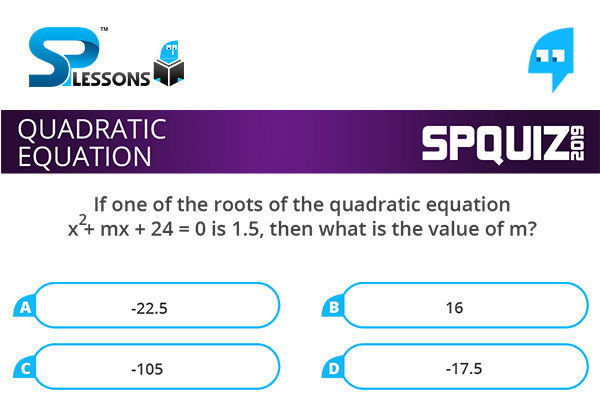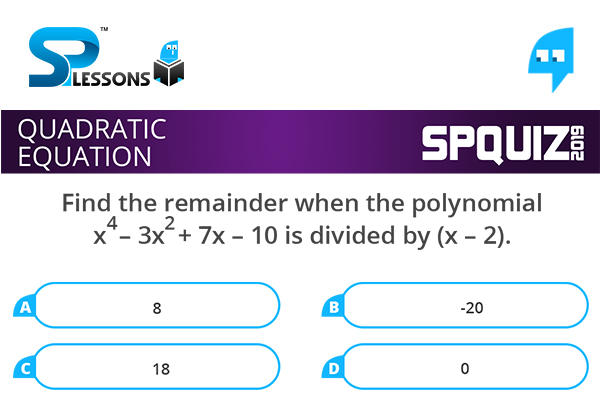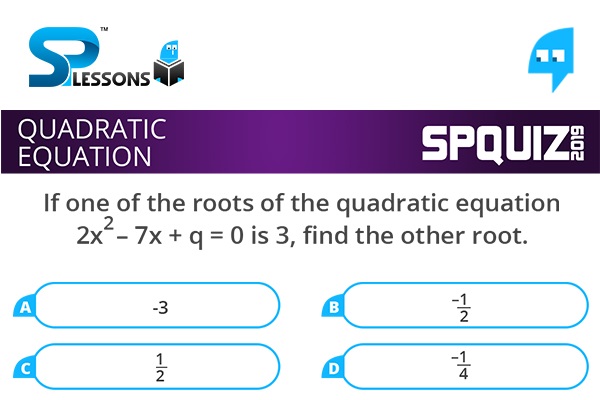 Introduction
Introduction
Quadratic Equation is one of important topic in Quantitative Aptitude Section. In Quadratic Equation – Quiz 5 article candidates can find questions with an answer. By solving this questions candidates can improve and maintain, speed, and accuracy in the exams. Quadratic Equation – Quiz 5 questions are very useful for different exams such as IBPS PO, Clerk, SSC CGL, SBI PO, NIACL Assistant, NICL AO, IBPS SO, RRB, Railways, Civil Services etc.
 Q1
Q1
If one of the roots of the quadratic equation [latex]{x}^{2}[/latex] + mx + 24 = 0 is 1.5, then what is the value of m?
- A. -22.5
B. 16
C. -105
D. -17.5
We know that the product of the roots of a quadratic equation a[latex]{x}^{2}[/latex] + bx + c = 0 is [latex]\frac{c}{a}[/latex]
In the given equation, [latex]{x}^{2}[/latex] + mx + 24 = 0, the product of the roots = [latex]\frac{24}{1}[/latex] = 24.
The question states that one of the roots of this equation = 1.5.
If [latex]{x}_{1}[/latex] and [latex]{x}_{2}[/latex] are the roots of the given quadratic equation and let [latex]{x}_{1}[/latex] = 1.5.
Therefore, [latex]{x}_{2}[/latex] = [latex]\frac{24}{15}[/latex]= 16.
In the given equation, m is the co-efficient of the x term.
We know that the sum of the roots of the quadratic equation a[latex]{x}^{2}[/latex] + bx + c = 0 is
[latex]\frac{-b}{a}[/latex] = [latex]\frac{-m}{1}[/latex] = -m
Sum of the roots = 16 + 1. 5 = 17 = -17.5.
Therefore, the value of m = -17.5
 Q2
Q2
Find the remainder when the polynomial [latex]{x}^{4}[/latex] - 3[latex]{x}^{2}[/latex] + 7x - 10 is divided by (x - 2).
- A. 8
B. -20
C. 18
D. 0
By remainder theorem: If a polynomial in one variable 'x' is divided by (x - a), where 'a' is any real number, then the remainder is the value of the polynomial at x = a.
Therefore, remainder = [latex]{(2)}^{4}[/latex] - 3[latex]{(2)}^{2}[/latex] + 7(2) - 10 = 8
 Q3
Q3
If one of the roots of the quadratic equation 2[latex]{x}^{2}[/latex] - 7x + q = 0 is 3, find the other root.
- A. -3
B. [latex] \frac {-1}{2}[/latex]
C. [latex] \frac {1}{2}[/latex]
D. [latex] \frac {-1}{4}[/latex]
Substituting x = 3 in the given equation we get
2([latex]{(3)}^{2}[/latex]) - 7 (3) + q = 0. Therefore, q = 3
Now, the given equation becomes 2[latex]{x}^{2}[/latex] - 7x + 3 = 0
By solving this we get (x - 3) (2x - 1) = 0
i.e., x = 3 & [latex]\frac{1}{2}[/latex]. The second root is [latex]\frac{1}{2}[/latex].
 Q4
Q4
If [latex]{(x + 2)}^{2}[/latex] = 9 and [latex]{(y + 3)}^{2}[/latex] = 25, then the maximum value of x/y is ____.
- A. [latex]\frac{1}{2}[/latex]
B. [latex]\frac{5}{2}[/latex]
C. [latex]\frac{5}{8}[/latex]
D. [latex]\frac{1}{8}[/latex]
[latex]{(x + 2)}^{2}[/latex] = 9
[latex]\rightarrow[/latex] x + 2 = ± 3
[latex]\rightarrow[/latex] x = 1 or -5
and [latex]{(y + 3)}^{2}[/latex] = 25
[latex]\rightarrow[/latex] y + 3 = ± 5
[latex]\rightarrow[/latex] y = 2 or -8
Therefore, maximum value of [latex]\frac{x}{y}[/latex] = [latex]\frac{-5}{-8}[/latex] = [latex]\frac{5}{8}[/latex]
 Q5
Q5
For what value of 'm' will the quadratic equation [latex]{x}^{2}[/latex] + mx + 4 = 0 have real and equal roots?
- A. 4
B. -4
C. 4 or -4
D. 16
The question states that the roots of the equation are real and equal.
Note:
The roots of a quadratic equation of the form a[latex]{x}^{2}[/latex] + bx + c = 0 will be real and equal if its discriminant D = [latex]{b}^{2}[/latex] - 4ac = 0
In this case, b = m, a = 4 and c = 4.
Therefore, [latex]{m}^{2}[/latex] - 4 * 4 * 1 = 0
Or [latex]{m}^{2}[/latex] = 16
Or m = +4 or m = -4.








